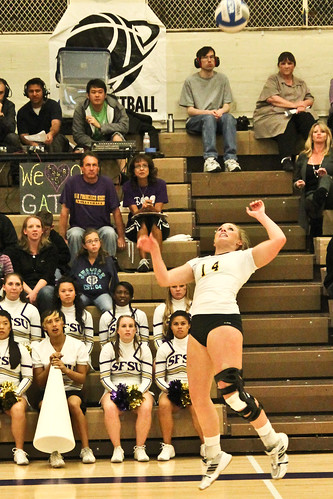No one joins a team to sit on the bench, but for SF State’s injured student athletes, that’s exactly where they find themselves.

Student athletes already juggle school, sports and travel, but when they’re injured they also have to worry about rehab, eligibility and even allowing more time to get around campus.
“That’s why I want to get off my crutches as soon as possible. It’s just exhausting trying to get around campus,” said soccer player Mike McNeill, a junior.
McNeill tore his right ACL during the Sept. 3 game, only the second game of the season.
“I just want to get out there and play again,” he said.
McNeill underwent surgery to repair the ligament three weeks after injuring the knee.
“There were six incisions in my leg. That’s obviously pretty painful, recovering from that,” McNeill said.
Unfortunately every case is different, he said, so there’s no timeline for his recovery. As a junior he only has one season left in his college career, so there will be a lot of focus on rehabilitating this spring.
In the meantime, it’s an injury that has turned every facet of his life completely upside-down.
“I used to be able to walk to campus, (now) I have to take a bus, so that’s terrible,” McNeill said. “A lot of times you end up not doing stuff that you usually do just because it’s so much of a burden to get around.”
It’s a concern of the conditioning staff as well, according to head athletic trainer Bryce Schussel.
“Getting around, especially in the winter with all the rain, and if they’re on crutches… that’s one of our biggest fears, (that) they’re on crutches, they’re in a brace and we’re doing rehab in here but then they go and rehurt themselves due to the weather,” Schussel said.
While there is the new, day-to-day minutia of living with the injury, McNeill just misses being active.
“It’s crazy because soccer’s been a part of my life, you know,” McNeill said. “I’ve been playing every day for 12 years and to have it suddenly taken away, not just the soccer part, but the physical activity aspect, taken away from you, for whatever it’s going to be – five, six, seven months – it’s pretty tough.”
Volleyball player Megan Johnson also knows what it’s like to tear a knee ligament. As a freshman at Cal Baptist University, she tore the PCL in her left knee at a practice drill.
“I thought it was just a zinger,” Johnson said. “I kept running back and forth doing a drill and I realized that I would go one way and my knee would go another. I went (into) panic mode and was just like ‘What did I do to my knee?’”
Fortunately, she said, it happened during the spring so she didn’t miss any playing time. Still, the injury changed her life.
“Snowboarding, water skiing, stuff like that, those are some of the things that I love but I’m not going to do them until after volleyball because it’s way too big of a risk,” Johnson said. “I’ve kind of just accepted that it’s always going to be this way.”
Her passion for the sport, however, makes it all worth it.
“It’s how you adapt to it. It’s how you play with it,” Johnson said. “You can just roll over and give up or you can say, ‘I can beat this. I can play with this.'”
Teammate Melissa Horton agrees. Horton, a freshman, missed the first seven matches of the season due to an aggravated stress fracture on her left tibia.
“It was hard because coming in as a freshman I was really excited, and then all of a sudden my pain increased so much, so fast and I couldn’t tolerate it because I couldn’t even walk without having a shooting pain up my leg,” Horton said.
Before the season began she said her pain was at an eight or nine on a scale of one to 10. Now it’s under five, but she still has to arrive 45 minutes earlier than normal every day to warm up the leg.
Extra time in the training room is something the trainers see a lot.
“I would say that the athletes that are injured, and the ones that are trying to be preventative, they’re spending a lot of time,” Schussel said. “It’s not just a two or three hour practice; it’s an hour, you know, hour and a half before practice and they’re in here doing treatment and rehab after practice.”
Horton was given a large, plastic boot to wear and crutches to help take the pressure off the bone, and it helped the injury, but made daily life harder.
“It was really difficult, especially having it be like uphill for all of my classes,” she said. “The boot is really heavy so I felt like I was dragging my leg behind me.”
That was nothing, however, compared to missing matches because of the injury.
“It’s just something that mentally, you have to overcome,” Horton said. “You have to just mentally get over that and just push through the point of pain and just focus on something else. You love the sport so you do what you have to play it, when you have a passion for something and you have that drive to continue.”







